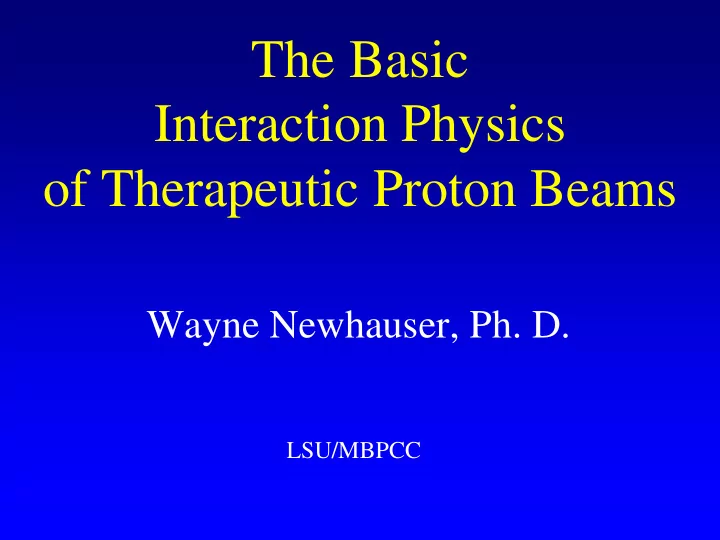

The Basic Interaction Physics of Therapeutic Proton Beams Wayne Newhauser, Ph. D. LSU/MBPCC
2 W. Newhauser, LSU/MBPCC
Objectives • Review basic proton interaction physics • Understand why protons offer some clinical advantages • Introduction to some proton therapy equipment and technology 3 W. Newhauser, LSU/MBPCC
Physics Overview • Basic interaction physics – Energy loss (penetration range) – Scattering (particle trajectory) – Range straggling – Bragg curves – Spread out Bragg Peaks 4 W. Newhauser, LSU/MBPCC
Energy Transfer Mechanisms Elastic scattering Excitation with nucleus Brems- Ionization strahlung Most energy loss is via coulombic interactions with atomic electrons. Small deflections are caused by coulombic interactions with nucleus. Nuclear reactions play only a small role. 5 W. Newhauser, LSU/MBPCC
Energy-Loss Rate , Proton Range 6 W. Newhauser, LSU/MBPCC
Range Energy Relation (Geiger’s Rule) R = E p Constant(1.77) Range Materials Initial [cm] constant energy 2.2e-3 [MeV] For protons in water where E < 200 MeV. 7 W. Newhauser, LSU/MBPCC
Stopping Power Calculation: Bethe Bloch Same constants as Bohr’s W. R. Leo. Techniques for Nuclear and Particle Physics Experiments. Springer, Berlin, 1987. 8 W. Newhauser, LSU/MBPCC
Stopping Power Calculation: Bethe Bloch W. R. Leo. Techniques for Nuclear and Particle Physics Experiments. Springer, Berlin, 1987. Dependencies z 2 Ion charge: 1/ v 2 (1/ 2 relativistically) Ion velocity: Ion mass: Buried in the W max term N a Z / A = N e = e - density Absorber: ln (1/ I 2 ) 9 W. Newhauser, LSU/MBPCC
Stopping Power Calculation: Bethe Bloch • Mean excitation potential ( I ) – Main parameter of Bethe Bloch formula – Theoretically related to logarthmic average of orbital frequencies of electrons, weighted by oscillator strengths of atomic levels. – Very difficult theoretical problem. In practice, deduced by fitting measured d E /d x to Bethe Bloch formula. 10 W. Newhauser, LSU/MBPCC
Stopping Power Calculation: Bethe Bloch • Bloch Correction: Important for low velocity particles. Takes into account departure from first-order Born approximation used by Bethe. • Barkas Correction: Particles of opposite charge have different stopping powers. • Shell Correction: as projectile slows down to velocity of orbital electron, assumption that electrons are stationary breaks down. • Density-Effect Correction: E -field of ion polarizes the atoms along trajectory. Polarization shields distant electrons from full E field. Stopping power is reduced. 11 W. Newhauser, LSU/MBPCC
Range Straggling σ = 0.012 R 0.935 ICRU Report 49, 1993 12 W. Newhauser, LSU/MBPCC
Range Straggling 13 W. Newhauser, LSU/MBPCC
Comparison of SOBP Model with Experimental Data Pristine Peaks from NPTC cyclotron Newhauser, in prep 14 W. Newhauser, LSU/MBPCC
Range Straggling Smears out the Bragg Peak Newhauser, in prep 15 W. Newhauser, LSU/MBPCC
Multiple Coulomb Scattering Highland’s approximation of Moliere’s theory as a gaussian: Lateral Displacement r RMS = 0.029 R .896 16 W. Newhauser, LSU/MBPCC
Single Proton Beam 138 MeV initial mean beam energy Gaussian initial energy distribution (σ E = 0.5 mev). Gaussian axially symmetric dose profile ( σ = 0.7 cm) 17 W. Newhauser, LSU/MBPCC
Making a Spread-Out Bragg Peak Newhauser, in prep 18 W. Newhauser, LSU/MBPCC
Making SOBPs Range Modulator Wheel Andy Koehler (Harvard Cyclotron Lab.) 19 W. Newhauser, LSU/MBPCC
SOBPs: Model v Measurement Newhauser, in prep 20 W. Newhauser, LSU/MBPCC
Compare CAX PDD 21 W. Newhauser, LSU/MBPCC
Rhabdomyosarcoma of Paranasal Sinus (7 y old boy) 160 MeV 6 MV Protons Photons (2 field) (3 field) Proton Photon IMRT IMRT (9 field) (9 field) Miralbell et al., IJROBP 2002 22 W. Newhauser, LSU/MBPCC
Review of Proton Beam Properties 1) Proton beams stop - no exit dose 2) Laterally, proton beams have sharp penumbra 3) Proton beams provide very uniform target dose distributions 4) Proton dose distributions can be made to conform tightly to irregular target shapes in all three dimensions 4) Clinically, the radiobiology of proton beams is almost identical to that of photon beams 5) Hence, protons offer a significant clinical advantage and it is mainly due the ability sharpshoot with dose. 23 W. Newhauser, LSU/MBPCC
Dynamic Beam Scanning • Sweep small proton beam over a large tumor using magnetic beam deflection. • Modulate beam range and fluence for each spot. Some more… A few pencil beams A proton pencil beam A full set, with a together…. (spot)…... homogenous dose conformed distally and proximally Images courtesy of Eros Pedroni, PSI (Switzerland) 24 W. Newhauser, LSU/MBPCC
Scanning Nozzle Beam 3.2m Beam Profile Monitor Scanning Magnets Vacuum Chamber Spot Position Monitor Dose Monitor 1, 2 IsoCenter Courtesty of Hitachi 25 W. Newhauser, LSU/MBPCC
IMPT versus Passive Scattered Proton Therapy Passively Scattered Proton Beam Actively Scanned Proton Beam Matsuda et al. 2009, Hitachi Reviews 58 (5) 26 W. Newhauser, LSU/MBPCC
For More Details … 27 W. Newhauser, LSU/MBPCC
END 28 W. Newhauser, LSU/MBPCC
Recommend
More recommend